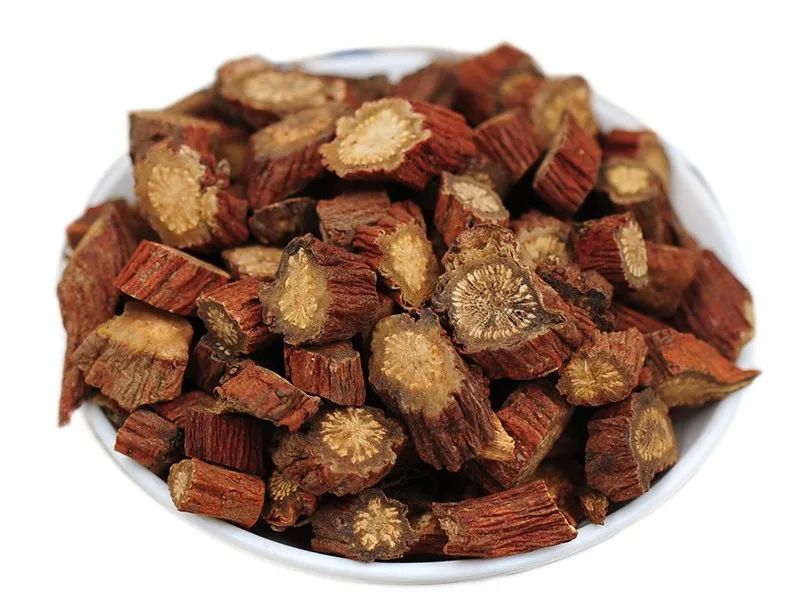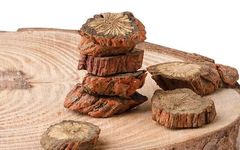

Dan Shen (Salvia miltiorrhiza) is the dried root and rhizome of the plant belonging to the Lamiaceae family. The medicinal herb is referred to as Dan Shen. The main chemical components of Dan Shen are divided into two categories: lipophilic diterpenoid compounds and hydrophilic polyphenolic acids. The lipophilic components include Dan Shen Keton I (Tanshinone I), Dan Shen Keton II A (Tanshinone IIA), and Hiding Dan Shen Keton (Dihydrotanshinone). The hydrophilic components include Dan Shen Su (Salvianolic acid), Dan Shen Suan Jia (Methyl salvianolate), Dan Shen Suan Yi (Ethyl salvianolate), Dan Shen Suan Bing (Propyl salvianolate), Raw Catechin (Caffeic acid), and Raw Catechin Aldehyde (Caffeic aldehyde). Additionally, it contains flavonoids, triterpenes, and sterols.
In China, 70% of medicinal materials are sourced from the wild. With the increasing understanding and demand for the medicinal value of Dan Shen, wild resources are diminishing. To meet domestic medication needs, many regions across the country have initiated the cultivation of Dan Shen, but often rely on local resources, leading to significant quality differences due to cultivation in different regions. Although cultivated Dan Shen has been included in the pharmacopoeia, in practice, the genetic resources of cultivated Dan Shen are quite mixed, cultivation techniques are not standardized, and management is inconsistent, resulting in large variations in the content of medicinal components and significant differences in yield. A systematic evaluation and selection of existing cultivated genetic resources to identify high-yield, high-quality, and high-efficacy new varieties, as well as exploring scientific cultivation techniques, remain urgent issues to be addressed in the future production of Dan Shen.


Properties and Channels:
Bitter in taste, slightly cold in nature. It enters the Heart and Liver meridians.
Functions and Indications:
Activates blood circulation and removes blood stasis, regulates menstruation and alleviates pain, clears the heart and calms the mind, cools the blood and resolves abscesses.
Clinical Applications:
Used for chest obstruction and heart pain, abdominal and flank pain, masses and accumulations, heat bi pain, irritability and insomnia, menstrual irregularities, dysmenorrhea, and painful sores.
Dosage:
Decoction: 10-15g.
Precautions:
Should not be used in conjunction with Li Lu (Veratrum).

Dan Shen is widely distributed in North China, East China, Central South, Northwest, and Southwest regions. It is generally believed that Dan Shen from Shandong, Henan, and Sichuan is of superior quality compared to other regions.

Dan Shen is a perennial herbaceous plant, growing to a height of 30-120 cm, with the entire plant densely covered in white soft hairs. The roots are cylindrical, brick red or bright red. The stems are erect and quadrangular. The odd-pinnate compound leaves have petioles 1-7 cm long, with 3-7 leaflets, the terminal leaflet being larger. The leaflets are ovate or oval-ovate, measuring 1.5-8 cm in length and 0.8-5 cm in width, with a blunt tip, a wide wedge-shaped or oblique round base, and serrated edges, with the underside densely covered in white soft hairs. The umbellate inflorescence has 6 or more flowers, forming terminal or axillary racemes, densely covered in glandular hairs and long soft hairs; the calyx is bell-shaped, brown-red, with a bilabiate apex, densely covered in white soft hairs; the corolla is blue-purple or pale purple. The flowering period is from May to August, and the fruiting period is from August to September, with the fruit being a nut.



Environmental Requirements:
Cultivated Dan Shen is mainly distributed in Henan, Shandong, Sichuan, Hebei, and Shaanxi. Wild Dan Shen is suitable for sunny, humid environments such as forest edges, grassy slopes, and roadside areas.
Temperature Requirements:
The optimal growth temperature is 20-26°C, with a relative humidity of 80%. The average annual temperature is generally 11-17°C, at altitudes above 500m, with an average annual precipitation of over 500mm.
Moisture Requirements:
The roots of Dan Shen are well-developed, reaching lengths of 60-80 cm, and it is sensitive to drought and waterlogging, thus should not be planted in poorly drained low-lying areas.
Soil Requirements:
Dan Shen can be cultivated in soils with pH levels ranging from slightly acidic to slightly alkaline, but it grows best in sunny, deep, moderately fertile, well-drained sandy loam.

 Dan Shen naturally grows as a perennial herb, with the above-ground parts starting to wilt in December. Seedlings or old plants left in the field begin to green again in March of the following year, while those propagated from roots sprout a month later. The first rapid growth phase after transplanting occurs 30-70 days after greening. It takes about 60 days from greening to budding and flowering, at which point seeds begin to form. After the seeds mature, the plant’s growth transitions from reproductive growth back to vegetative growth, with nutrients in the leaves and stems concentrating towards the roots, resulting in the first growth peak. The period from August to October is the fastest growth period for the roots.
Dan Shen naturally grows as a perennial herb, with the above-ground parts starting to wilt in December. Seedlings or old plants left in the field begin to green again in March of the following year, while those propagated from roots sprout a month later. The first rapid growth phase after transplanting occurs 30-70 days after greening. It takes about 60 days from greening to budding and flowering, at which point seeds begin to form. After the seeds mature, the plant’s growth transitions from reproductive growth back to vegetative growth, with nutrients in the leaves and stems concentrating towards the roots, resulting in the first growth peak. The period from August to October is the fastest growth period for the roots.


